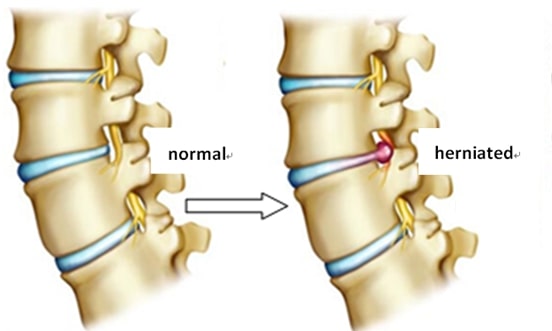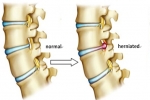
Symptoms of a lumbar herniated disc vary widely from moderate pain in the back and buttock to widespread numbness and weakness requiring immediate medical care.
In the vast majority of cases, the pain eases within six weeks. But despite its short duration, the pain can be excruciating and make it difficult to participate in everyday activities and responsibilities. For some, the pain can become chronic and/or debilitating.
Common Lumbar Herniated Disc Symptoms
It is common for a herniated disc to press against, or inflame, a nearby nerve, causing pain to radiate along the length of the nerve. A lumbar herniated disc is the most common cause of sciatica, leg pain along the sciatic nerve down the back of the leg.
These are some general characteristics of lumbar herniated disc pain:
- Leg pain. The leg pain is typically worse than low back pain. If the pain radiates along the path of the large sciatic nerve in the back of the leg, it is referred to as sciatica or radiculopathy.
- Nerve pain. The most noticeable symptoms are usually described as nerve pain in the leg, with the pain being described as searing, sharp, electric, radiating, or piercing.
- Variable location of symptoms. Depending on variables such as where the disc herniates and the degree of herniation, symptoms may be experienced in the low back, buttock, and front or back of the thigh, the calf, foot and/or toes, and typically affects just one side of the body.
- Neurological symptoms. Numbness, a pins-and-needles feeling, weakness, and/or tingling may be experienced in the leg, foot, and/or toes.
- Foot drop. Neurological symptoms caused by the herniation may include difficulty lifting the foot when walking or standing on the ball of the foot, a condition known as foot drop.
- Lower back pain. Lower back pain may be present, but not always. The low back pain may be described as dull or throbbing and may be accompanied by stiffness. If the herniated disc causes lower back muscle spasm, the pain may be alleviated somewhat by a day or two of relative rest, applying ice or heat, sitting in a supported recliner or lying flat on the back with a pillow under the knees.
- Pain that worsens with movement. Pain may follow prolonged standing or sitting, or after walking even a short distance. A laugh, sneeze, or other sudden action may also intensify the pain.
- Pain that worsens from hunching forward. Many find that positions such as slouching or hunching forward in a chair or bending forward at the waist make the leg pain markedly worse.
- Quick onset. Lumbar herniated disc pain usually develops quickly, although there may be no identifiable action or event that triggered the pain.
Lumbar herniated disc symptoms are usually more severe if the herniation is extensive. Pain can be milder and limited to the low back if the disc herniation does not affect a nerve.
In some cases, low back pain or leg pain that occurs for a few days then goes away is the first indication of a herniated disc.
Rare but Dangerous Symptoms of Lumbar Herniated Disc
A loss of bladder or bowel control, lower back pain, numbness in the saddle area, and/or weakness in both legs are signs of a rare but serious condition called cauda equina syndrome.
This pressure and swelling of the nerves at the end of the spinal column can lead to paralysis and other permanent impairments if treatment is delayed. Emergency medical treatment, which may include testing and surgery, is needed if these symptoms occur.
Location of Nerve Impingement Is Key
Symptoms of a herniated disc can vary depending on the location of the nerve, as nerve pathways are different at each level of the spine. For example:
- L3 or L4 impingement from a herniated disc may lead to an abnormal reflex when the area just below the knee is tapped with the rubberized reflex hammer. This is called the patellar reflex. Pain from an L3 or L4 impingement usually radiates to the quadriceps femoris muscle at the front of the thigh. This is different from sciatica, which runs along the back of the leg.
- L5 nerve impingement (at the L4-L5 level) from a herniated disc can cause symptoms such as weakness in extending the big toe and potentially in the ankle, which leads to difficulty with the heel-to-toe motion in walking. This weakness is called foot drop. Numbness and pain may be felt on top of the foot, and the pain may also radiate into the buttock.
- S1 nerve impingement (at the L5-S1 level) from a herniated disc may cause loss of the ankle reflex and/or weakness that makes it difficult for patients to stand on their toes or on the ball of the foot. Numbness and/or pain can radiate along the outside of the calf, down to the sole or outside of the foot and the toes.
Symptoms attributed to a herniated lumbar disc may have other causes. A thorough physical exam, medical evaluation, and sometimes-diagnostic imaging tests are commonly needed to determine the source of pain and other symptoms.
Please contact our office at (516) 419-4480 or (718) 215-1888 to arrange an appointment with our Pain Management Specialist, Dr. Jeffrey Chacko.













